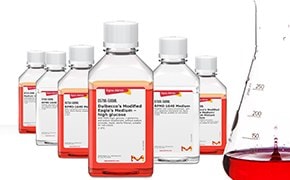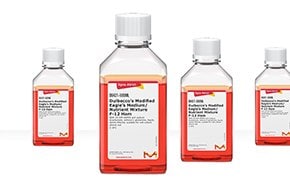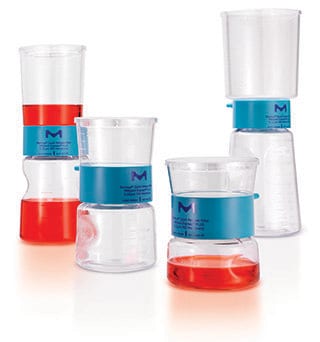Classical Media & Buffers

Cell culture media variations have been refined to fit the need for more physiologically-relevant environments for diverse mammalian cell cultures. These media and salts, along with their components, have been qualified for a wide range of cell culture applications, and are manufactured in our state-of-the art facilities. Choose media fit for your application based on you parameters, including glucose concentration, L-glutamine or stable glutamine supplementation, phenol red pH indicator inclusion, and powdered or liquid formats.
Products
DMEM (Dulbecco’s Modified Eagle Medium)
DMEM (Dulbecco’s Modified Eagle Medium) is the most broadly suitable medium for many adherent cell phenotypes among defined media for cell and tissue culture. The Dulbecco’s modification is an enhanced supplementary formulation that boosts select amino acid and vitamin content of the original Eagle’s medium by up to fourfold. Our selection includes a range of glucose concentrations, as well as formulations with and without L-glutamine. Products without the pH indicator phenol red are available for estrogen-sensitive applications, and our comprehensive offering includes convenient, ready-to-use liquid formats, as well as economical powdered media for easier storage and longer shelf life.
RPMI 1640 Media
Named for the Roswell Park institute where it was developed by Moore et al, RPMI 1640 media are optimized for culturing non-adherent cell types, such as lymphocytes and other blood cells. The formulation is based on the RPMI 1630 series of media utilizing a bicarbonate buffering system and alterations to the amounts of amino acids and vitamins. RPMI 1640 medium has been used for the culture of human normal and neoplastic leukocytes. When properly supplemented, this formulation has demonstrated wide applicability for supporting growth of many types of cultured cells, including fresh human lymphocytes in the 72 hour phytohemagglutinin (PHA) stimulation assay.

DMEM/F12 Media Formulations
In recent years, researchers have reported the culture of a variety of cell lines in serum-free medium that contained a supplement of nutrients, growth factors and hormones in the place of serum. Mather and Sato (BBRC, 1985) reported the successful cultivation of Leydig and Sertoli cells in serum-free medium that contained insulin, transferrin, epidermal growth factor, leutinizing hormone or follicle stimulating hormone, somatomedin and growth hormone. Although the hormones and their concentrations are specific for the type of cell under study, the medium found to be optimal for these studies was a 1:1 mixture of Dulbecco's Modified Eagle's Medium (DMEM) and Ham's F-12 Nutrient Mixture, also known as DMEM/F12. HEPES buffer can be included in the formulation at a final concentration of 15 mM to compensate for the loss of buffering capacity incurred by eliminating serum.

MEM (Minimum Essential Medium)
Developed by Harry Eagle working at the NIH, Minimum Essential Medium (MEM) contains essential amino acids universal to multispecies needs, and is one of the most widely used of all synthetic cell culture media. Early attempts to cultivate normal mammalian fibroblasts and certain HeLa cells subclones revealed that they had specific nutritional requirements that could not be met by Eagle's Basal Medium (BME). Subsequent studies using these and other cells in culture indicated that additions to BME could be made to aid growth of a wider variety of fastidious cells. MEM, which incorporates these modifications, includes higher concentrations of amino acids so that the medium more closely approximates the protein composition of mammalian cells.
MEM has been used for cultivation of a wide variety of cells grown in monolayers. Optional supplementation of non-essential amino acids to the formulations that incorporate either Hanks' or Earle's salts has broadened the usefulness of this medium. The formulation has been further modified by optional elimination of calcium to permit the growth of cells in suspension.
Ham’s F-10 and F-12 Media Formulations
Ham's nutrient mixtures were originally developed to support the growth of several clones of Chinese hamster ovary (CHO) cells, as well as clones of HeLa and mouse L-cells, but are also suited for hepatocyte culture, viral fusion, and toxicity assays. These mixtures were formulated for use with or without serum supplementation, depending on the cell type cultured.
- Ham's F-10 has been shown to support the growth of human diploid cells, white blood cells, and primary explants of rat, rabbit and chicken tissues.
- Ham's F-12 has been used for the growth of primary rat hepatocytes and rat prostate epithelial cells. A clonal toxicity assay using CHO cells has been reported using Ham's F-12, also available with 25 mM HEPES that provides more effective buffering in the optimum pH range of 7.2 - 7.4
- Coon's modification of Ham's F-12 was developed for culturing hybrid cells produced by viral fusion. This modification consists of 2x the standard concentration of amino acids and pyruvate, plus the inclusion of ascorbic acid and adjusted salt concentrations. The Coon’s formula contains 0.863 mg/L zinc sulfate, which may render it unsuitable for culturing mouse L-cells.
- Kaighn's modification of Ham's F-12 (also called Ham’s F-12K) has increased concentrations of select amino acids and pyruvate, as well as modified salts (Konigsberg’s formula). This medium was designed to support the growth of differentiated rat and chicken cells, as well as primary human hepatocytes.
Medium 199 (M199)
Early tissue culture media were predominantly formulated from animal products and/or tissue extracts. In 1950, Morgan and his coworkers reported their efforts to produce a strictly defined nutritional source for cell cultures. Their experiments, conducted with various combinations of vitamins, amino acids, and other factors revealed that growth of explanted tissue could be measured in what has become known as Medium 199 (M199), now widely used in virology, vaccine production, primary tissue explant culture, and the in vitro cultivation of mouse pancreatic epithelial and rat lens tissues.
Researchers eventually found that long-term cultivation of cells required addition of a serum supplement to the culture fluid. When properly supplemented, Medium 199 has broad species applicability, particularly for cultivation of non-transformed cells.
Basal Salts for Cell Culture
D-PBS, Hanks’, Earle’s, Tyrode’s — you’ll find the correct formulation for your culture application in the most complete collection of balanced salts available anywhere.
Other Classic Cell Culture Media
Find specialized formulations including Ames’ and Iscove’s modifications, plus Click’s, L-15, McCoy’s, NCTC, and more.
To continue reading please sign in or create an account.
Don't Have An Account?